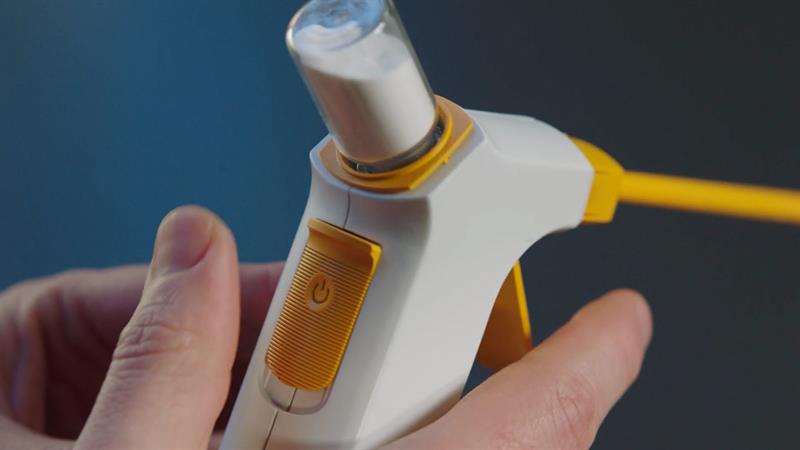The desire to create a device that eliminates this risk led UK-based medical device consultancy Team Consulting to embark on a development programme that this year emerged with a revolutionary new design.
Dr Ben Wicks, head of MedTech at Team Consulting says: “Haemostat powders are widely used to manage bleeding during surgery – the powder accelerates clotting and can easily be sprayed onto an area of bleeding using an air spray device. However, such devices generally rely on air to deliver the powder particles. The presence of air brings the risk of embolism if the device is placed too close to a vein, and we wanted to come up with a solution that could eliminate this entirely.”
Clearly, since air was the problem, the development had to centre around creating an an airless system for delivering powdered hemostats accurately, safely and cheaply.
Says Dr Wicks: “We saw that the existing products for haemostat delivery could be safer and more convenient, so we challenged the team to come up with something better. They came back with various ideas, one of which used the Coanda principle, where air follows a curved surface.”
The principle was named after Romanian aerodynamics pioneer Henri Coanda, who was the first to recognise the practical application of the phenomenon in aircraft development. It is described as “the tendency of a jet of fluid emerging from an orifice to follow an adjacent flat or curved surface and to entrain fluid from the surroundings so that a region of lower pressure develops.”
On this basis, Team Consulting set about developing a powder sprayer which could never cause embolism. Called Convesaid, its ingenious airflow design uses the Coanda principle to ensure that only the haemostat powder exits the device. No air leaves the device and hence the sprayer is intrinsically safe.
The battery-powered pump inside Convesaid creates a stream of air, which picks up the haemostat powder particles and blows them out of the end of the device. The air, however, is funnelled round a smooth curve in the tip of the device. No air ever leaves the device.
Instead, the air follows the curve within the nozzle and is directed back into the device itself. Powder is ejected without any air leaving the opening, which means even if the nozzle were pushed into a vein, it can’t inject any air. This eliminates any potential for air embolism and is what makes Convesaid so intrinsically safe.
Simplicity, reliability, robustness and cost-effectiveness were key aspects in the design of Convesaid. Team Consulting estimates the device would cost around $15 to manufacture. These were always major factors in the design brief, as Dr Wicks makes clear. “As well as eliminating the risk of embolism, we also wanted to create a device that was easy to operate, reliable and cheap enough to be disposable,” he says.
 Like any design process, however, it was not straightforward. Says Dr Wicks: “We created initial design concepts and used math modelling to simulate the device’s airflow and used this work to create the first prototype.”
Like any design process, however, it was not straightforward. Says Dr Wicks: “We created initial design concepts and used math modelling to simulate the device’s airflow and used this work to create the first prototype.”
Following successful demonstration of the first prototype, Team Consulting gathered user feedback to further refine the design. The original prototype was connected to an external pump and power source, but feedback suggested a handheld solution would better to meet stakeholder needs. It was also discovered that people pulled the trigger before switching on the device, so Team Consulting redesigned the device’s layout to feature a lock-out which prevents the trigger from activating until the device has been switched on.
Says Dr Wicks: “We ran some computer simulations, designed and built our first demonstrator – which worked brilliantly. The next challenge was to make it smaller – so more design work, prototyping and testing followed. The spray is almost like magic, it feels like air must be coming out, but it isn’t.”
According to the company: “User feedback was invaluable throughout the process, and this is typical of the way we develop products for our clients: we develop devices from understanding user needs, through design, lab testing and user studies – all the way to scale up and manufacture.”
The result is a product that is suitable for use in both laparoscopic and open surgery. Because the powder is delivered without air and as a fine, fully-controllable jet, surgical teams are able to focus on the procedure at hand and do not have to worry about embolism. Ultimately, the device saves time, money and – most crucially – lives.
Say Dr Wicks: “Convesaid gives surgeons the ability to stop a variety of bleeds in a rapid, accurate and safe way. It takes no time to set up and is unencumbered by any air lines. Convesaid will give haemostat manufacturers the ability to deliver haemostats more effectively, more conveniently and, above all, more safely than ever before.”
Of course, the development of Convesaid also has other advantages for Team. Says Dr Wicks: “We’ve developed countless medical devices over the years, but much of what we do is confidential. So Convesaid is like a concept car for us, a non-confidential way to illustrate how we work and what device development actually looks like up close.”
Dr Wicks concludes: “In a nutshell, Convesaid illustrates how we care about all aspects of development, from the clever new technology and engineering to the user experience and industrialisation. “It’s how we work and how we think.”
Team Consulting Team Consulting was officially formed in 1986 by five colleagues who had worked together at PA Consulting (Andy Fry, Perran Newman, Alan Goodman, John Targell and Peter Sharpe). In 1997 the company decided to specialise in medical device development. Prior to this we had worked in a number of different sectors, but this focus gave us the opportunity to explore its potential developing products that could make a real difference to people’s lives. Today, the company specialises in drug delivery in the respiratory and parenteral drug delivery sectors and medical devices. Its clients come to it to develop pioneering devices for new treatments, interventions and tools that often require innovative new technologies or manufacturing systems. |






